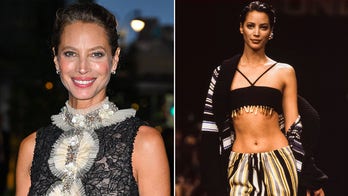
Vice Magazine's Fiction Issue includes a fashion spread that depicts the suicides of female authors like Iris Chang (right) using fashion models. (Vice/AP)
NEW YORK – After being widely condemned for publishing a fashion spread featuring models posing as female writers who killed themselves, Vice Magazine has removed the "Last Words" photo essay from its website.
“The fashion spreads in VICE magazine are always unconventional and approached with an art editorial point-of-view rather than a typical fashion photo-editorial one," the magazine said in a statement to FOX411. "'Last Words' was created in this tradition and focused on the demise of a set of writers whose lives we very much wish weren’t cut tragically short, especially at their own hands. We will no longer display 'Last Words' on our website and apologize to anyone who was hurt or offended."
The images will however still be available in the magazine's 2013 Fiction Issue, which has already been published.
Said offending images include a model portraying poet Sylvia Plath kneeling in front of an open gas oven. Another model portrays historian Iris Chang holding a revolver to her mouth.
Alongside each photo is a caption with the writer’s birth and death date and the way they died.
Also accompanying each photo is a description of the clothes the model is wearing – “Issa dress, Morgenthal Frederics glasses, Jenni Kayne shoes.”
The Chinese writer Sanmao hung herself with her tights. Alongside her depiction is the factoid that the tights the model used for her noose are the Look brand from London.
And while most of the suicides occurred many years ago, at least one, Chang’s, happened in 2004. The celebrated author of “The Rape of Nanking” left a two-year old son, who would be 11 now.
Many critics have accused the magazine of dangerously portraying suicide as being sexy.
Writing for The Guardian in England, where Vice has offices, Helen Lewis cites studies that show including the method of suicide in reports of suicide increases the occurrence of copycats.
“Every year in England and Wales, about 24,000 young people between the age of 10 and 19 attempt suicide. What will children in that kind of distress see when they look at those Vice pictures? They will see a menu,” Lewis writes. “Using famous women makes it worse, because vulnerable people can fixate on a favorite writer and identify with them.”
The fact that these were real-life suicides involving real-life women and their families has also struck a nerve.
“These weren't fictional characters; these were real women, who lived and struggled and died, and to treat their lowest moments as fodder for a silly fashion spread is shameful and sad,” Jenna Sauers wrote on Jezebel.com.
Vice portrays itself as an edgy youth brand, but many also note that it is a massive company with offices in more than a dozen countries, a weekly newsmagazine show on HBO, and a CEO, Shane Smith, who recently proclaimed to New York Magazine that Vice’s goal is to become nothing less than “the largest network for young people in the world.”
Part of that strategy is of course a massive online presence. Vice’s YouTube channel has over a million subscribers, and its social media presence, with almost 1.3 million Facebook friends and 380,000 Twitter followers, is huge.
Michele Filgate at Salon.com suspects the suicide spread was published with that online audience in mind.
“Art can and at times should be provocative — there’s no doubt about that,” Filgate said. “Yet this isn’t art. This is an editorial decision to get more page views — and perhaps to appear cool and above outrage, while simultaneously stoking it — and it’s more pathetic than anything else. “
A rep for HBO didn’t immediately return FOX411’s request for comment.






